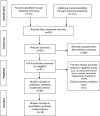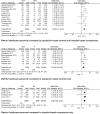The Occupational Risk of Influenza A (H1N1) Infection among Healthcare Personnel during the 2009 Pandemic: A Systematic Review and Meta-Analysis of Observational Studies
- PMID: 27579923
- PMCID: PMC5006982
- DOI: 10.1371/journal.pone.0162061
The Occupational Risk of Influenza A (H1N1) Infection among Healthcare Personnel during the 2009 Pandemic: A Systematic Review and Meta-Analysis of Observational Studies
Abstract
Introduction: The aim of this review was to record systematically and assess the published literature relating to the occupational risk of influenza A (H1N1) infection among healthcare personnel during the 2009 pandemic.
Methods: The literature search was performed in June 2015. An update was carried out in May 2016. It was applied to the electronic databases EMBASE, MEDLINE, PsycINFO, PubMed, CINAHL and Google Scholar. The quality assessment was conducted with a tool using eight criteria. A meta-analysis was carried out to compute pooled effect estimates for influenza A (H1N1) infection.
Results: A total of 26 studies were included in the review, 15 studies met the criteria for the meta-analysis. After a sensitivity analysis the pooled analysis showed a significantly increased odds for influenza A (H1N1) infection for healthcare personnel compared to controls/comparisons (OR = 2.08, 95% CI = 1.73 to 2.51). The pooled prevalence rate for healthcare personnel alone was 6.3%.
Conclusions: This review corroborates the assumption that healthcare personnel were particularly at risk of influenza A (H1N1) infection during the 2009 pandemic. Healthcare facilities should intensify their focus on strategies to prevent infections among healthcare personnel, especially during the first period of pandemics.
Conflict of interest statement
The authors have declared that no competing interests exist.
Figures


Similar articles
-
Weight and prognosis for influenza A(H1N1)pdm09 infection during the pandemic period between 2009 and 2011: a systematic review of observational studies with meta-analysis.Infect Dis (Lond). 2016 Nov-Dec;48(11-12):813-22. doi: 10.1080/23744235.2016.1201721. Epub 2016 Jul 6. Infect Dis (Lond). 2016. PMID: 27385315
-
Factors influencing pandemic influenza vaccination of healthcare workers--a systematic review.Vaccine. 2012 Jul 6;30(32):4733-43. doi: 10.1016/j.vaccine.2012.05.018. Epub 2012 May 27. Vaccine. 2012. PMID: 22643216
-
COVID-19 and H1N1-09: A Systematic Review of Two Pandemics with a Focus on the Lung at Autopsy.Front Biosci (Landmark Ed). 2022 Jun 7;27(6):182. doi: 10.31083/j.fbl2706182. Front Biosci (Landmark Ed). 2022. PMID: 35748258
-
Intimate partner violence among women of reproductive age during the COVID-19 pandemic in Ethiopia: a systematic review and meta-analysis.BMJ Public Health. 2025 Feb 4;3(1):e001161. doi: 10.1136/bmjph-2024-001161. eCollection 2025. BMJ Public Health. 2025. PMID: 40017976 Free PMC article.
-
Measures implemented in the school setting to contain the COVID-19 pandemic.Cochrane Database Syst Rev. 2022 Jan 17;1(1):CD015029. doi: 10.1002/14651858.CD015029. Cochrane Database Syst Rev. 2022. Update in: Cochrane Database Syst Rev. 2024 May 2;5:CD015029. doi: 10.1002/14651858.CD015029.pub2. PMID: 35037252 Free PMC article. Updated.
Cited by
-
Experiences of health professionals diagnosed with COVID-19 in coping with the disease.Int Nurs Rev. 2022 Jun;69(2):185-195. doi: 10.1111/inr.12752. Epub 2022 Feb 24. Int Nurs Rev. 2022. PMID: 35201624 Free PMC article.
-
[COVID-19 as an occupational disease or work-related accident: Considerations regarding insurance cover and reporting obligation in the statutory accident insurance].Dtsch Med Wochenschr. 2021 Feb;146(3):198-204. doi: 10.1055/a-1341-7867. Epub 2021 Jan 4. Dtsch Med Wochenschr. 2021. PMID: 33395708 Free PMC article. German.
-
Low SARS-CoV-2 seroprevalence but high perception of risk among healthcare workers at children's hospital before second pandemic wave in Germany.World J Pediatr. 2021 Oct;17(5):484-494. doi: 10.1007/s12519-021-00447-8. Epub 2021 Aug 20. World J Pediatr. 2021. PMID: 34415560 Free PMC article.
-
Influenza vaccination in healthcare workers: A comprehensive critical appraisal of the literature.Hum Vaccin Immunother. 2018 Mar 4;14(3):772-789. doi: 10.1080/21645515.2017.1348442. Epub 2017 Oct 20. Hum Vaccin Immunother. 2018. PMID: 28787234 Free PMC article. Review.
-
COVID-19-Related Mental Health Effects in the Workplace: A Narrative Review.Int J Environ Res Public Health. 2020 Oct 27;17(21):7857. doi: 10.3390/ijerph17217857. Int J Environ Res Public Health. 2020. PMID: 33120930 Free PMC article. Review.
References
-
- Centers for Disease Control and Prevention (CDC). Outbreak of swine-origin influenza A (H1N1) virus infection—Mexico, March-April 2009. MMWR 2009; 58: 467–470. - PubMed
-
- World Health Organization (WHO). World now at the start of 2009 influenza pandemic. Statement to the press by WHO Director-General Dr. Margaret Chan; 2009. Available: http://www.who.int/mediacentre/news/statements/2009/h1n1_pandemic_phase6....
-
- World Health Organization (WHO). H1N1 in post-pandemic period. Director-General's opening statement at virtual press conference 10 August 2010; 2010. Available: http://www.who.int/mediacentre/news/statements/2010/h1n1_vpc_20100810/en/.
-
- World Health Organization (WHO). Pandemic (H1N1) 2009—update 112; 2010a. Available: http://www.who.int/csr/don/2010_08_06/en/.
Publication types
MeSH terms
LinkOut - more resources
Full Text Sources
Other Literature Sources
Medical
Miscellaneous

